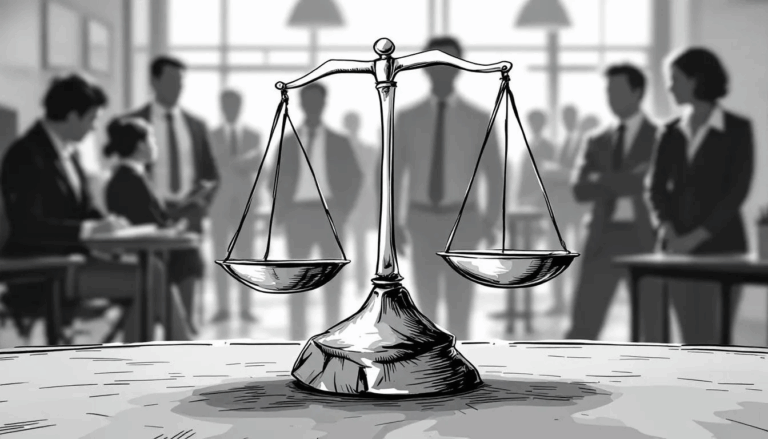Overcoming Gender Discrimination: Essential Guidance for Affected Employees in Texas
In Texas workplaces, gender discrimination is an entrenched barrier to equality, manifesting in unfair treatment and diminished opportunities for affected employees. This article outlines how discrimination surfaces, its impact on your career and well-being, and actionable steps to claim your rights under federal and Texas laws.
Key Takeaways
- Gender discrimination in Texas includes unfair treatment based on gender, sex, or gender identity, leading to workplace issues like a pay gap, career advancement barriers, and pregnancy discrimination.
- Texas and federal laws protect against gender discrimination including the Civil Rights Act and Texas Labor Code. Knowing your rights and the role of EEOC and TWC is crucial in addressing discrimination.
- To tackle gender discrimination at work, recognize signs like pay disparities or biased treatment, understand internal reporting procedures, and don’t hesitate to seek legal assistance if necessary.
Understanding Gender Discrimination
What does gender discrimination entail? It’s an unfair or disadvantageous treatment based on an individual’s gender, including sex, gender identity, or gender expression. This discrimination is often rooted in societal and personal biases about gender roles and expectations. Hence, it’s crucial to debunk these stereotypes and foster an environment of mutual respect and gender equality.
Transgender, non-binary, and gender non-conforming individuals often face heightened discrimination, manifesting as hate, fear, misunderstanding, or erasure, a phenomenon known as cissexism. Similarly, women, including trans women, experience inequality and limitations due to gender-based discrimination, stereotyping, and persistent prejudice. In the workplace, this discrimination can take various forms, including:
- Misgendering
- Denying access to appropriate facilities
- Derogatory language
- Intimidation based on one’s gender
Types of Gender Discrimination
The gender pay gap is a glaring example of gender discrimination, with women earning less than men for the same roles. Women also frequently encounter barriers in reaching senior management roles due to limited development prospects, external commitments, and networking opportunities. Pregnancy discrimination is another prevalent form of gender discrimination, often leading to women being overlooked for hires and advancements.
Gender-based harassment, often non-sexual, targets women as well as transgender and gender non-conforming individuals through offensive language or behavior, including instances of physical harassment and unwanted sexual advances. Implicit bias also leads to subtle instances of discrimination. Assigning women to clerical tasks during meetings, often without conscious awareness, is an example.
Sexism, a belief in the inferiority of typically one gender over another, drives unequal societal treatment and impacts behaviors of a sexual nature, including same sex relationships and expectations of sexual favors. Gender norms socialization also casts women in nurturing roles and men as leaders, affecting how they are perceived and treated across different settings.
The Impact on Employees
How does gender discrimination impact employees? It can obstruct employees’ career paths by forcing them into roles that do not match their qualifications or aspirations, hindering their ability to attain higher positions and grow professionally. This discrimination also affects an employee’s mental well-being and job satisfaction, impacting their performance and sense of belonging.
The overall effect is a work environment that fails to value and capitalize on the skills and talents of all employees equally. It’s essential for employers and employees alike to recognize these impacts and work towards eliminating any form of gender bias in the workplace.
Know Your Rights: Federal and Texas Laws Against Gender Discrimination
Arming yourself with knowledge of your rights is a powerful step in combating gender discrimination. Federal laws like Title VII of the Civil Rights Act, the Equal Pay Act, and the Pregnancy Discrimination Act protect employees from gender discrimination. In Texas, the Labor Code Chapter 21, or the Texas Commission on Human Rights Act (TCHRA), parallels the protections of Title VII against employment discrimination based on sex.
Moreover, Texas Labor Code Section 21.106 specifically addresses discrimination on the basis of pregnancy, childbirth, or related medical conditions as a form of sex discrimination. The Supreme Court’s decision in Bostock v. Clayton County, GA, expanded Title VII’s prohibition on discrimination based on sex to also encompass discrimination based on sexual orientation and gender identity. Understanding these laws can be complex, making legal assistance crucial to navigate the intricacies of gender discrimination claims under federal and state laws.
Equal Employment Opportunity Commission (EEOC)
The Equal Employment Opportunity Commission (EEOC) plays a pivotal role in combating gender discrimination. It enforces federal laws protecting job applicants and employees from discrimination based on sex, which includes pregnancy, gender identity, and sexual orientation. The EEOC investigates allegations of gender discrimination and can file lawsuits on behalf of affected individuals.
Before pursuing legal action through a lawsuit, employees must file a discrimination complaint with a government agency like the EEOC. Fortunately, employees can file a complaint with the EEOC without needing to file separately with the Texas Workforce Commission, thanks to the dual filing system, ensuring compliance under both federal and state or local laws. An EEOC lawyer can walk you through the system.
Texas Workforce Commission
Closer to home, the Texas Workforce Commission (TWC) enforces state laws against discrimination in employment, including gender discrimination, and works to ensure fair and equitable treatment of workers in Texas. The TWC’s Civil Rights Division is responsible for enforcing the Texas Labor Code’s provisions against employment discrimination, including gender discrimination.
The TWC also handles complaints regarding employment discrimination under the Texas Labor Code Chapter 21 and assists individuals in filing charges of discrimination. Having these institutions in place ensures that Texans have resources to turn to when they encounter gender discrimination at work.
Identifying Gender Discrimination in the Workplace
Recognizing gender discrimination is the first step towards addressing it. Signs of gender discrimination in the workplace can manifest as:
- Being treated worse than colleagues
- Lower earnings
- Receiving less support from supervisors
- Being given less challenging tasks, solely based on one’s gender
It’s crucial to remember that workplace discrimination, including gender discrimination, can occur at any stage of employment, from the hiring process through to termination or retirement.
Common Examples of Gender Discrimination
Some common examples of gender discrimination include derogatory comments, objectification, sexist humor, and exclusionary masculine practices, which contribute to a toxic work environment. There’s also unequal career opportunities, where women are often assigned traditionally feminized tasks like note-taking or organizing refreshments, and overlooked for promotions.
Companies often promote male employees and offer them greater training opportunities over female employees, which exemplify advancement disparities due to gender discrimination. A lack of transparency in promotion processes often hides the bias behind why employees of a certain gender are not chosen for advancement.
Different words used to describe men and women in performance evaluations often reflect gender bias. For instance, women may be called ‘bossy’ while men are called ‘decisive’ for the same behaviors.
Subtle Forms of Discrimination
Subtle forms of discrimination are often harder to identify but can be just as damaging. Implicit sexism, or implicit bias, refers to unconscious and automatic prejudiced judgments and behaviors, which can result in discrimination even without overt intent. Mid-career women often report facing more gender bias or discrimination, particularly between their mid-30s to late 40s, including unfair assumptions about their capabilities or commitment, and unequal access to career advancement opportunities.
The perception of gender equality in the workplace is often lacking, with less than half of EU citizens believing gender equality has been achieved at work. Addressing unconscious bias can be facilitated through:
- Bias training programs
- Anonymous hiring processes
- Diverse interview panels
- Clear guidelines against discrimination and harassment.
Reporting and Addressing Gender Discrimination
Once you have identified gender discrimination, it’s essential to take action. Employees should familiarize themselves with their employer’s policies on reporting discrimination, which is usually detailed in the Employment Manual or Handbook. Filing an internal complaint involves reporting discriminatory behavior or policies to HR or a direct supervisor.
To support your complaint, document incidents of gender discrimination, including recording dates, times, witnesses, and any communications with HR or supervisors. Store this information in a secure location outside of work. For union members, the option exists to file a grievance through the union’s collective bargaining agreement, if it includes provisions for discrimination issues.
Filing a Complaint Internally
Filing an internal complaint involves:
- Reporting concerns about discrimination to Human Resources or a supervisor in writing
- Keeping copies of all communications
- If the complaint is made verbally, taking notes during the conversation and sending a follow-up email or letter to confirm what was discussed.
However, internal complaints should not be delayed as they do not extend the deadline for filing legal action. Confidential reporting guidelines must be enforced to ensure that any concerns or incidents of gender discrimination are addressed promptly and appropriately.
Seeking Legal Assistance
When facing workplace sexual harassment, seeking legal assistance is vital. Consulting with a Dallas sexual harassment attorney can help employees understand their legal rights and potential options, as well as provide expertise on validating the legal merit based on the specifics of the harassment. A sexual harassment lawyer can assist in examining the evidence to prove that illegal sexual harassment occurred, and offer support and protection throughout the legal process, including filing a sexual harassment complaint.
Free, confidential legal advice and assistance is available through programs like Legal Advice & Counseling. Proper legal representation ensures the complaint about gender discrimination is filed accurately and within legal time limits, which is critical for the success of any legal action taken.
Case Studies: Real-Life Examples of Gender Discrimination
Real-life examples of gender discrimination often necessitate legal action for resolution, highlighting the essential role of advocacy and the legal system in dealing with such issues. Consider the case of an employee subjected to a hostile work environment for not conforming to male sexual stereotypes and his person’s sexual orientation, demonstrating a case of gender-based harassment with significant personal impact.
Victims of gender discrimination have received substantial compensation, like the $100,000 awarded in the case of harassment based on sex and disability, showing tangible recognition of the harm suffered. Legal resolutions have also mandated the enforcement of anti-discrimination policies and employee training, as seen in several cases involving harassment based on sexual orientation and sex.
Successful Lawsuits
Successful lawsuits have resulted in affirmative outcomes for employees facing discrimination, promoting a fairer workplace. In EEOC v. Deluxe Financial Services Corp., the transgender employee was awarded $115,000 in damages, and the company was ordered to provide transgender employees with access to restrooms conforming to their gender identity and eliminate sex-based exclusions from health plans.
In EEOC v. Lakeland Eye Clinic, P.A., a $150,000 settlement was awarded to the employee wrongfully terminated due to gender identity, alongside mandatory gender discrimination policies and training implementation. EEOC v. VXI Global Solutions, Inc. saw a $600,000 settlement for victims of a sexually hostile work environment and retaliation, with a requirement for the company to develop LGBT workplace issue training.
These legal actions have compelled businesses to establish and enforce non-discriminatory practices and educational programs for a more inclusive work environment.
Lessons Learned
From these cases, employees who have faced gender discrimination have learned the importance of understanding their rights and the proper steps to report and challenge such incidents. Employers, on the other hand, have learned that fostering a positive work culture and enforcing a zero-tolerance policy for discrimination can reduce legal risks and improve the company’s reputation.
Applying these lessons leads to improved workplace policies, more informed employees, and better-equipped management, all contributing to a fairer work environment. After all, a workplace that values diversity and equality is not just a legal necessity but also a key factor in creating a productive and positive work environment.
Summary
In conclusion, gender discrimination remains a pressing issue in many workplaces, including in Texas. However, understanding its various forms, recognizing its signs, being aware of the legal rights and protections, and knowing how to report and address such incidents is a big step towards combating this issue. Let’s strive for workplaces where everyone, regardless of their gender, can thrive and succeed.
Frequently Asked Questions
What is the gender discrimination law in Texas?
In Texas, Title VII and the Texas Labor Code protect employees from discrimination based on sex, sexual preference, sexual orientation, and gender identity, ensuring that everyone has the right to work free of discrimination.
What is the meaning of gender inequality?
Gender inequality is when one gender is consistently favored or given more privileges and opportunities than another due to their sex or gender, violating the fundamental human right to equality. It’s not okay and needs to change.
What is gender discrimination in the workplace?
Gender discrimination in the workplace refers to unfair treatment based on an individual’s gender, including sex, gender identity, or gender expression, leading to unequal treatment and opportunities. Discrimination can result in lower pay, less support from supervisors, and being assigned less challenging tasks.



